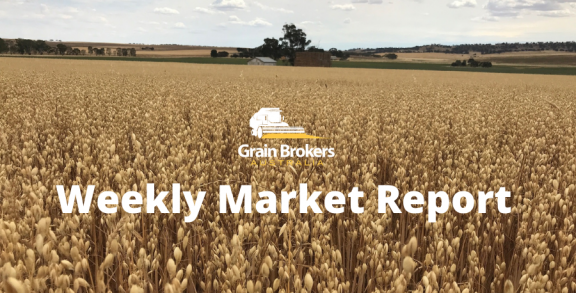
Taxes on the export of Russian wheat came into effect last week in conjunction with an export quota, and this will be followed in March by taxes on corn and barley exports.
In December last year, Moscow announced restrictions on the export of grain in an effort to curb food inflation. Firstly, an export quota to limit exports of wheat, barley, corn and rye to 17.5 million metric tonnes (MMT) between February 15 and June 30 this year. And secondly, an export tax on wheat of €25 (AU$41.50) per metric tonne in effect for the same period.
Last month, the Russian government doubled the tax on wheat to €50 (AU$83) per metric tonne effective from March 1. At the same time, they announced an export tax on corn and barley would be set at €25 (AU$41.50) per metric tonne and €10 (AU$16.60) per metric tonne, respectively from March 15 to June 30.
As if that wasn’t enough government intervention, early this month, Moscow announced that the fixed taxes would be replaced by a floating tax from June 2, a month earlier than the market had expected, and it will remain in place indefinitely. This move is likely to make Russian wheat prices relatively expensive moving forward.
This variable export levy will be imposed on wheat, corn and barley, and will require sellers to register their export contracts on the Moscow Exchange from April 1. The government will then calculate market benchmarks for each commodity based on the export selling prices, and these will be used to establish the tax value.
Under this system, the floating tax will be triggered if the market benchmark price exceeds the government’s base export price thresholds. The difference in value between the market benchmark price and the base export price will attract a tax of 70%. The government has set the base export price indicators at US$200 for wheat and US$185 for both barley and corn.
Now it seems the Russian government has taken a leaf out of Trump’s book on free-market economics. Just like the US collected taxes on Chinese imports and distributed the proceeds to the US farmer: Moscow and domestic millers have apparently agreed on a few billion roubles of subsidies to help businesses remain viable and combat higher domestic prices.
So, part of the state’s money from the proposed export taxes will be directed into helping domestic consumers pay higher prices for their wheat. A tax intended to curb inflation will, in fact, likely lead to higher inflation: a classic market oxymoron. And I am sure the government intervention will not end there.
The continuation of an export tax into the new crop slot has provided an incentive for the Russian farmer to sell, especially with a market inverse of around US$40 per metric tonne. However, a big question mark remains around new crop production in Russia, and this may be a big enough incentive for the grower to hold for the time being.
According to leading Russian agricultural consultancy, Sovecon, Russia’s 2021 wheat harvest is likely to be considerably lower than last year. It downgraded its 2021 forecast last week by 1.5MMT to 76.2MMT compared to 85.9MMT 2020 harvest. Sovecon said the crop entered winter in the worst shape in a decade after an unseasonably dry autumn, and while January weather was beneficial, February was disappointing.
A significant proportion of Sovecon’s production cut was taken out of spring wheat output. It expects the Russian farmer to vote with their wallet and cut plantings following the introduction of the permanent formula-based export tax. Sovecon cut its spring wheat harvest forecast by 1MMT to 22.6MMT.
Russia is currently the world’s biggest exporter of wheat, accounting for around 20 per cent of global trade. The taxes have already had an impact by helping to lift already inflated global prices and disrupting international tenders. Russia is generally the leading indicator of export prices, but it is effectively out of the market while there is so much uncertainty around the new crop tax regime. The market is confused.
On the positive side, the Russian export restrictions plus smaller wheat crops in both the European Union and Argentina have been a bonanza for the Australian farmer. Russian prices have been pushed to six-year highs, and now the European Union market has finally realised that the global balance sheet is getting tighter.
Global wheat trade in the 2002/21 marketing year is edging higher, and demand remains resilient. Chinese imports continue to outstrip expectations, and importing countries are keen to build inventories. Concerns persist over new crop supply shortages as the coronavirus pandemic enters its second year.
While tensions between Beijing and Canberra persist, China has continued to buy Australian wheat. December exports to China were a record 800,000 metric tonne, almost double the previous mark, and while not as high, January shipments were still quite strong.
Chinese importers were active in the Australian market leading up to Chinese New Year and are rumoured to have purchased upwards of 400,000 metric tonne for March to May shipment and at least 200,000 metric tonne for shipment in the May-June period. And there are expectations that the buying spree will continue post New Year with the possibility that sorghum will be added to the shopping list.
What about barley, I hear you ask? While it is highly unlikely we will be fielding interest from China in the near term, there is little cause for concern. Despite the doom and gloom after Beijing imposed tariffs last year, Australian barley has been finding plenty of export friends, and the shipping pace is well ahead of trade expectations.
Call your local Grain Brokers Australia representative on 1300 946 544 to discuss your grain marketing needs.





